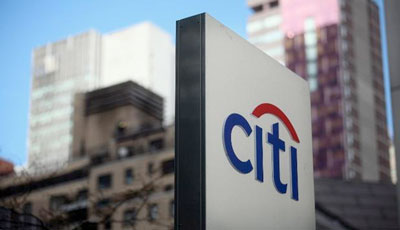Citigroup’s ‘Bad Bank’ Isn’t So Bad Anymore

Citi Holdings, the ‘bad bank’ Citigroup created to dispose of unwanted assets, has become a surprise success story
Citi Holdings was born to be bad. But it is getting better with age.
The “bad-bank” unit of Citigroup Inc., Citi Holdings for more than six years has been the repository for businesses the banking giant wanted to dump: its retail brokerage and life insurance unit, an array of toxic subprime loans, even a stake in a Mexican auto supplier.
Now, after years of losses, the unit has reported four profitable quarters in a row. It also has sold more than $700 billion in assets, an amount that rivals the balance sheets of Goldman Sachs Group Inc. and Morgan Stanley.
“We’re out of the dark tunnel,” says Francesco Vanni d’Archirafi, the executive who has run the unit since 2013.
Citi Holdings was born out of the detritus that was Citigroup after the financial crisis. Then-CEO Vikram Pandit moved about $900 billion worth of businesses and loans into the unit, a combination of assets that were either toxic, underperforming or simply no longer fit Citigroup’s business model. The idea was to sell them or let them run off, while allowing Citigroup to focus investor attention on its core businesses and acquiesce to government pressure to get smaller and less risky.
For several years, big losses in the unit masked much of the progress. Despite recent momentum, Citi Holdings has lost about $60 billion for Citigroup, in large part due to distressed mortgage loans and large legal costs.
The surprising rebound has been fueled both by timely sales and an economic recovery that has helped troubled assets across the board.
“It’s pretty amazing how far they’ve come,” said Brennan Hawken, a UBS bank analyst. “If we said four years ago Citi Holdings is going to be consistently profitable, there’s no way that would have been believed.”
The unit is still sizable—at $116 billion in assets, it would rank in the top 30 U.S. bank holding companies. Citigroup executives are working to finish one of the unit’s biggest remaining deals, a sale of subprime lender OneMain Financial to its rival Springleaf Holdings Inc.
Citigroup officials including Mr. Vanni d’Archirafi are mum on plans for the unit, such as whether it will eventually be folded back into the bank. The bank hasn’t set any sort of public timeline around an endgame for Citi Holdings, though the 55-year-old Mr. Vanni d’Archirafi says there is “enough work for a few more quarters,” at least.
“The best example of success,” he adds, “will be when people stop talking about Citi Holdings.”
Although the unit is now profitable, Citigroup executives take more pride in how they are working to make it disappear. Citigroup CEO Michael Corbat, who was the first person to run Citi Holdings, keeps a framed bar chart in his office that shows the shrinking of the unit, a memento from his tenure there.
Regulators, lawmakers and investors have encouraged big banks to become more streamlined and less complex. But despite a market rebound that makes some asset sales easier, challenges remain: The pending deal to sell OneMain may be delayed from its original September closing date due to a Justice Department antitrust review.
The bank also must now find a way to sell assets that could prove hard to unload. The bank has said, for example, that there hasn’t been much of a market so far for U.S. home-equity loans; Citi Holdings still has $23 billion of them.
“What you get to at the end is the rock pile, which takes a lot of effort to get rid of,” notes Marty Mosby, an analyst with Vining Sparks.
Running a business in wind-down mode is an about-face for globe-hopping bank veterans like Mr. Vanni d’Archirafi. Born into a family of Italian diplomats, Mr. Vanni d’Archirafi speaks four languages and joined Citigroup out of grad school three decades ago. When he was offered the Citi Holdings job, he says, he wasn’t sure at first if he wanted it.

One challenge is keeping employees motivated after they learn that their business is going to be sold. Mr. Vanni d’Archirafi says his tack is to show employees how well some other units have done after being cut off from the parent.
The bank has moved assets both in and out of the unit. Several years ago, it moved some credit-card assets from Citi Holdings back into the bank. It also considered dumping its entire mortgage unit into Citi Holdings, but ultimately decided to preserve the part that makes new mortgages after deciding that its branches needed them, according to people familiar with the situation.
Some businesses Citigroup let go were once key building blocks of former CEO Sanford Weill, like life insurer Primerica Inc., which his company bought in 1988. Some employees there referred to the spinoff from Citigroup as “independence day.”
Citigroup sold other businesses with only loose ties to its core banking business, including a British music empire eventually sold to a consortium including the estate of pop star Michael Jackson. The bank also has sold off its stakes in a Mexican auto supplier, a Mexican airline, a Japanese company that runs call centers and a technology-support company in India.
Citi Holdings still holds about $51 billion in U.S. residential mortgage and home-equity loans, which have also improved along with the economy. The unit is no longer weighed down by heavy legal costs after sealing up a mortgage-securities settlement last year.
Citigroup has said only that its goal for Citi Holdings this year is to at least break even, something that may be tougher if profitable units like OneMain are gone.
The bank has more sales to come—more than one-quarter of the remaining assets in the unit have been pledged to be sold including the Japanese consumer bank.
Such sales can provide a one-time boost to the unit’s profits and improve Citigroup’s capital levels. When Citi Holdings was created, the company revamped how it paid the executives of businesses being sold, rewarding them for preserving capital rather than growing assets, according to people familiar with the situation.
In Mr. Vanni d’Archirafi’s Midtown Manhattan office, where the executive often arrives for a 7 a.m. staff meeting, one sign fits nicely with the current assignment: “A good project manager,” it says, “will be able to bring structure to disarray, order out of chaos, and success from the grasp of failure.”
Source: WSJ – Citigroup’s ‘Bad Bank’ Isn’t So Bad Anymore




























